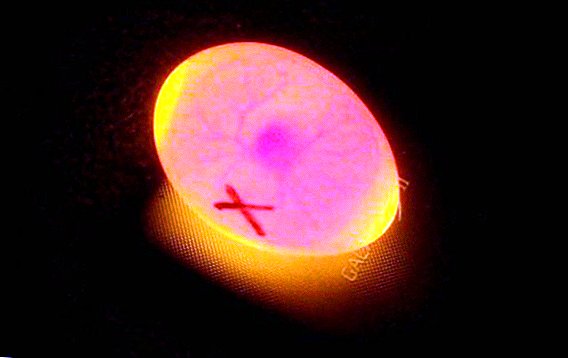 When breeding ducks at home, poultry farmers are faced with the problem of controlling the development of the embryo in the egg.
When breeding ducks at home, poultry farmers are faced with the problem of controlling the development of the embryo in the egg.
After all, if you know that the embryo is not viable or has malformations, then in the early stages it is possible to carry out a qualitative rejection of unsuitable eggs and thus significantly reduce the loss of individuals from the new brood.
This problem can be solved by a procedure known as ovoscoping.
What is ovoskopirovaniya
Ovoskopirovaniya is a process of scanning through duck eggs under a special lamp - an ovoscope.
The meaning of this procedure is that it allows you to identify the viability of the incubation material before laying it out for incubation, discard unsuitable specimens, and during incubation monitor the development of embryos and determine developmental defects in time.
Learn what ovoskop is and how to do it, how to ovoskopirovat eggs.
Ovoskop can be purchased inexpensively in a specialized store or make yourself. In the second case, it is enough to take a bright light bulb, whose power is not less than 100 W, and place it on the bottom of the cardboard box. At the top of the box you need to make a small hole, the size of a little smaller than the eggs, which will appear through. To improve the illumination under the bucket you can put a reflector.

Ovoskopirovanie - the procedure is not complicated and is very simple: an egg is placed above the light source, that is, on the hole in the box, scrolls slowly along the longitudinal line and is examined for deviations and developmental defects.
The main thing is to perform all actions very quickly and accurately during the control screenings during incubation. The speed of the procedure is a guarantee that the eggs will not have time to cool down, and accuracy will not damage the egg products themselves.
Did you know? Birds - one of the few representatives of the animal world, the embryonic development of which can be so carefully observed.
Translating is not recommended more than several times during the entire incubation period. Usually, it is enough to have 1 preliminary examination and 3 incubation at different stages of embryogenesis - on the 7th, 16th and 19th day of incubation.
Ovoskopirovaniya duck eggs by day
To carry out the procedure of ovoskopirovaniya recommended before laying the egg products in the incubator for the rejection of poor-quality material.
Further scanning is carried out 1 time at each of the 4 stages of embryo development:
- at the end of the first stage;
- at the end of the second stage;
- throughout the third stage;
- under completion of the fourth stage a few days before hatching.
 Ovoskopirovaniya duck eggs by day
Ovoskopirovaniya duck eggs by dayBefore laying
During this period, x-raying serves as a diagnostic criterion for rejection of duck eggs unsuitable for incubation.
First of all, the selection of egg material on its appearance.
Learn how to disinfect the incubator before laying eggs and eggs before incubating.
A quality egg should be:
- with a smooth, uniform and thick shell without any defects and cracks;
- regular oval shape without bulges and deformations;
- large weight, which for duck eggs should be in the range of 75-95 g.

For example, Subjects with such characteristics are subject to rejection:
- the yolk is completely immobile and looks sticky;
- the yolk, without the slightest binding, dangles from side to side (in fact, it should move a little, but keeping mainly the center and with difficulty);
- the yolk is not located in the center, and is shifted to the side;
- the edges of the yolk are unclear and blurry, indicating that spilled yolk;
- 2 yolks;
- the air chamber is too small or, on the contrary, too large;
- the air chamber is not on the side of the blunt end, but is shifted to either side;
- inside there are any inclusions - dark spots, stripes, sand, worms, moldy spots;
- cracks, scratches, chips are visible on the shell, the shell heterogeneity is noticeable, which indicates uneven distribution of calcium.
 Two-yolk egg with two embryos - ovoscoping
Two-yolk egg with two embryos - ovoscoping
It is not necessary to lay in the incubator egg material, which has seen at least one marriage of the above. Firstly, it is not economical in a place that is very limited in the incubation apparatus, and secondly, damaged eggs can cause the death of all other embryos, as they can be carriers of fungi, mold and bacteria.
Did you know? There is a myth that twin chicks can hatch from an egg with 2 yolks. However, this is impossible, since the space under the shell is very limited and it is not enough for the development of 2 embryos.
On the 7th day
The first control translucence of the incubation material is carried out at the end of the first stage of embryonic development. For duck eggs, this period falls on the 7th and 8th day after laying in the incubator.
During this period, it is still too early to cool duck eggs, so ovoscoping should be carried out as quickly as possible to minimize heat loss.

Take the ovoscope and apply each egg to the hole with the light source. Scroll it along the longitudinal line.
A good incubation material with a developing embryo will have the following signs under translucency:
- under a bright light, the contents under the shell have a pink tint;
- you can see a darker spot of the embryo in the form of a large comma with a slight rocking;
- the embryo is relatively mobile inside and moves slightly when moving the egg;
- the allantois circulatory system is clearly visible;
- well visible airbag.
Find out how to goose eggs.
But what signs should alert:
- egg products are bright and transparent;
- no blood vessels;
- no shade of the embryo when swaying;
- the embryo looks too dark and stuck to one side of the shell (however, the blood vessels can often be completely absent or, on the contrary, the presence of a blood ring around the yolk can be clearly visible);
- the presence of blood rings (this is an unequivocal sign of a dead embryo).

In the first 3 cases, we can say that the egg is unfertilized, and in the last 2 cases there is a fading of the embryo and the cessation of its development.
Important! Hatching eggs are considered frozen, in which the embryo died from the 7th to the 14th day of the incubation period. Most often, the embryo looks like a black comma stuck to one wall, and under the shell there is no vascular grid inside.
On the 16th day
At the end of the second stage of development, the second incubation of the incubation material is carried out. Now this process can be done less hastily, since from the 15th day of incubation duck eggs need cooling, which is carried out for 20 minutes. Therefore, ovoscoping can be combined with cooling and carefully examine all egg production.
The examination during this period is remarkable in that the embryo is now becoming the most noticeable, and the determination of its state becomes the simplest matter. 
Under the ovoskop the egg looks from the inside completely filled, the only bright spot is represented only by the air chamber. If you look closely, then inside you can consider the growing embryo. Also on the surface should be clearly visible blood vascular network.
At this stage, it is possible to accurately determine the frozen embryos and discard non-viable specimens.
Learn how to get ducklings from an incubator, how to feed ducklings from the first days of life, what vitamins to give to ducklings, what ducks can get.
For example, You can learn about the death of the duck embryo by the following features:
- the egg is completely translucent, and also appears transparent and empty, which means that the embryo has not even begun to develop;
- the embryo is completely immobile inside;
- the circulatory system is undeveloped or minimally developed;
- the air chamber takes up too much space;
- the embryo appears to stick to one wall of the shell;
- the embryo is almost indistinguishable inside, and the egg is too translucent.
Ovoskopirovaniya duck eggs on the 16th day of incubation: video
On the 19th day
The third ovoscopic procedure is carried out at the beginning of the third stage of development, when the embryo is almost fully formed. The scanning procedure can be carried out during the entire third stage up to the 25th day of incubation. However, the poultry farmers are of the opinion that the translucency on the 19-20th day will be the best option, since during this period the chick is already fully formed, but it is clearly visible inside the egg, and it can be easily understood whether it is viable or not.
Important! At this stage, those specimens that have clear signs of embryo fading are clearly rejected. - sticking to the wall, underdevelopment of blood vessels in combination with complete immobility.
The method of ovoskopirovaniya similar to the second stage, accompanied by cooling the incubation products and ends with spraying.
The criteria for assessing the viability of embryos are the same as in the previous stage, but now it is possible to evaluate the mobility of the embryo, since its movements under the shell are clearly visible. If the embryo does not show signs of life and does not move, then its viability is questioned. However, it is recommended to watch such an egg.

Last few days
The last screening is carried out 2-3 days before breeding, that is, on the 25-26th day of the incubation period.
At the same time, the egg material with practically assured development of the chick should look like this:
- the shell is almost not translucent, the contents look dark inside, since the embryo is already quite large and fills almost the entire egg;
- the air chamber is brightly shining, it should look distinct.
Important! "Zadohliki" - this is the name of the nestlings, frozen at the last stage of embryonic development.
If the following signs are observed, then we can say that the embryo is not viable:
- no movement under the shell is observed, the nestling is absolutely immobile;
- often the space around the airbag shines through more than necessary;
- a hollow patch may appear from the sharp side of the egg;
- Allantois blood vessels can be very blurred or even not visible at all.

Signs of an embryo development disorder
The disruption of the development of the embryo at different stages is characterized by such signs.
- The stratification of the subscale shells is manifested by the displacement of the air chamber toward or toward the sharp side of the egg.
- Too large air chamber indicates that the incubation material is old and old, and therefore unsuitable for breeding.
- If the egg appears absolutely orange or orange-red during translucence, this indicates that the yolk has burst and mixed with the white.
- If the hacks are torn off, the yolk will freely hang around the entire inside space.
- The yolk stuck to one wall of the shell - it means that the egg is either old or the storage conditions have been violated.
- The appearance of blood rings - this is how the death of the embryo is manifested in the early stages of incubation, when the yolk acquires blastoderm.
- Dark germ stuck to one side of the shell.
- Absence or underdevelopment of the blood vessels of the allantois.
- In the later stages, the embryo is immobile, and the circulatory system is underdeveloped.
- With insufficient warming up of eggs, the growth of embryos is delayed, which is why they lag in terms, and the number of "chokes" increases.
- Overheating causes uneven development, which is why ducklings bite with loose yolk sac or unused protein, and their mortality increases.
- With a lack of moisture, the eggs lose much weight, and the heat exchange increases, which leads to an increase in temperature inside the incubation material and causes developmental disorders. As a result, ducklings hatch early, and the conclusion is given to them with difficulty, since the shell becomes dense, shrinks and makes it much harder to stick.
- When there is an excess of moisture, there is an increase in the amniotic fluid, which is fatal to chicks, since when they are sluggish, they swallow this fluid and choke.
Did you know? Duck feathers have a specific water-repellent coating, which is why they do not get wet without special treatment.
Ovoskopirovaniya acts as a reliable and easy way to control the incubation of duck eggs. Translating allows you to reject unsuitable material before it is laid in the incubator, as well as to track the development of embryos during the entire incubation process and weed out non-viable individuals.
Ovoskopirovaniya hatching eggs: video












